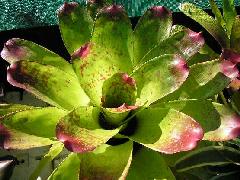
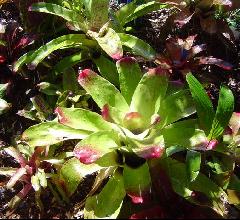
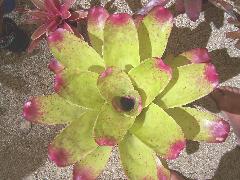
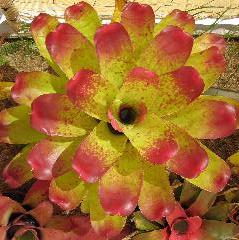
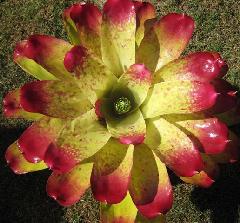
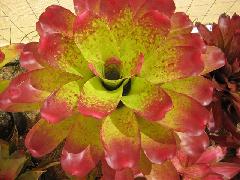
Now check Neoregelia correia-araujoi on fcbs.
If we accept that Neoregelia correia-araujoi is a natural hybrid of Johannis and some form of marmorata, then "Fairchild" , "Braz-el", and the confusion between them, may be understandable !
"Fairchild", johannis, Xcorreia-araujoi, marmorata, and "Braz-el" may all be part of one continuum.
From Uncle Derek says on http://fcbs.org .....
Is Neoregelia correia-araujoi Pereira & Penna, a natural hybrid?
First I must point out there is no stigma attached to a plant being called a natural hybrid. Most plants were at one time a natural hybrid it was just that some settled down to become treated by taxonomists as a species. There are many plants currently described as species which are most likely recent hybrids! But this should not stop us discussing odd happenings. Elton Leme is strongly of the opinion that this taxon is not a hybrid. This is what he had to say while showing photographic slides in the Report of proceedings at the Brom. Conference New Zealand 2003.
On the contrary Neo johannis grows in an area covered by forest close to the ocean. You can see it here in the south part of Rio de Janeiro, some rock formation and you can see when johannis grows on the rocks very close to the salt water. You can see here the level of the high tide and it is very adapted to the salt conditions. You can select all kinds of shapes and colours and I saw here and in many other places, different plants supposed to be hybrids or supposed to be cultivars but they are just selections of the typical populations. Here are some examples of different populations just two kilometres apart. You can also find variegated ones sometimes but these are a different category in terms of taxonomy and you can use a cultivar name. ( This is where DeRolf comes from.)
Another problem is Neo correia-araujoi, you can see that it has spotted leaves that never occur in the typical johannis. People used to say that correia-araujoi may be a natural hybrid between cruenta and marmorata but the populations of cruenta and marmorata are never in contact in the environment, Neo cruenta grows up north of Rio de Janeiro and johannis grows to the south. Neo marmorata grows in Sao Paulo state far away. Here is correia-araujoi in shade conditions, and you can see it is keeping the spots on the leaves.
This is the typical Neo marmorata from Sao Paulo, a smaller plant compared to correia-araujoi and johannis, with narrow leaves and a very peculiar kind of ornamentation. In the cruenta the petals are blue and in johannis, white. Here we have some white petals with tips of lilac, and also some shades of green in the lower part of the petals.
From Uncle Derek....
As far as I am aware N. cruenta has never been part of the discussion although there was much confusion up to the 1990s as to what constituted a N. cruenta and what was N. johannis. Elton does know where these species are found whereas we have to rely on reportings from publications such as Smith & Downs. As such we are unaware of the exact localities for N. johannis although we do know that N. marmorata has been reported from Parati in the state of Rio de Janeiro.
In 1983 Pereira and Penna described N. correia-araujoi and compared it with N. marmorata.
In the late 1980s Lisa Vinzant of Honolulu obtained two verified clones of N. correia-araujoi which she crossed in both directions. She got 1/4 to 1/3 plain green johannis type plants and the rest with some degree of marmoration.
In 1992 I obtained seed from Brazil called N. correia-araujoi and the resultant progeny included green johannis type plants which when flowered linked to the N. johannis description. Others seemed closer to N. marmorata but could not be linked directly to the N. marmorata description. This variable bunch retained the correia-araujoi name and were not given special cultivar names.
In private correspondence with Harry Luther I also found out that he too believed there was a link with these two species but I do not know what he based his opinion on.
Clearly, something odd was happening from two different sources. The problem is that hybridisation occurs more easily from plants held in Brazilian collections rather than in the wild but to have similar results from two different sources suggest that there is a close relationship with all three species. Whether you write N. correia-araujoi or N. Xcorreia-araujoi on your label is your decision.